


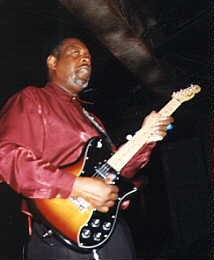 Famous Dave's, 4/16/98 Photo © 1998 by Ray Stiles. All rights reserved |
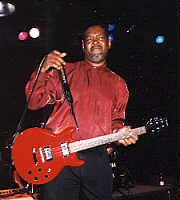 Photo © 1998 by Ray Stiles. All rights reserved |
Carl had some strong musical support from Calvin Skipgaskin on bass and Chucky Watts on drums. These guys knew how to PLAY, and with just a look from Weathersby they knew when to really "kick it" or take the song into a different direction.
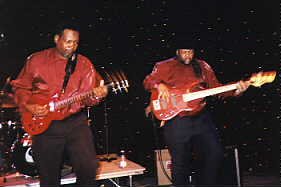 Famous Dave's, 4/16/98 Photo © 1998 by Ray Stiles. All rights reserved |
Weathersby likes to wander around while playing, back and forth on the stage or out in the audience. One time he even wandered back stage - who knows what he was doing. I asked him later if it was the ribs Famous Dave had brought back during the break he was sneaking a bite of and he said there is no way he could play with that on his hands and in his mouth. Later he even wandered out into the hall of Calhoun Square playing to some surprised late night shoppers.
Tom Hunter joined the band on keyboards during second set at Famous Dave's request. Carl was a little skeptical at first and was going to test him on an easy song to see what he was made of. So they did the John Hiatt song "Feels Like Rain," found on Weathersby's "Looking Out My Window" CD. Carl turned this Buddy Guy hit into a beautiful soul ballad and Hunter must have passed mustard because Carl was having a great time the rest of the night playing off of Hunter's frantic keyboard playing.
Born in Jackson, Mississippi, November. 24, 1953, Carl moved to Chicago when he was 11. He grew up surrounded by blues and gospel -- one of his cousins was Baby Doo Caston (who played with Willie Dixon). He said some of his guitar influence were Albert King, BB King, Little Milton, and Jimi Hendrix.
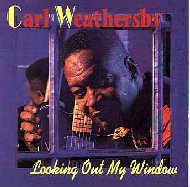 Last year he released his second solo Evidence album "Looking Out My Window." Prior to that time he spent a decade and a half as the driving force behind Billy Branch's Sons of Blues band. In the late 70's and early 80's he also spent time on the road with Albert King. When asked about his time on the road with King Weathersby said, "It was hard to stay (with Albert) full time. He was demanding, but that's the way most people that try to master their art are. The coach of the Vikings is not going to settle for slop, and that's the same way with Albert, he demanded that you give him your all when you played his music. There was no way you can watch Albert King and not see something or feel something when he played, I don't think it was possible because he played with so much emotion."
Last year he released his second solo Evidence album "Looking Out My Window." Prior to that time he spent a decade and a half as the driving force behind Billy Branch's Sons of Blues band. In the late 70's and early 80's he also spent time on the road with Albert King. When asked about his time on the road with King Weathersby said, "It was hard to stay (with Albert) full time. He was demanding, but that's the way most people that try to master their art are. The coach of the Vikings is not going to settle for slop, and that's the same way with Albert, he demanded that you give him your all when you played his music. There was no way you can watch Albert King and not see something or feel something when he played, I don't think it was possible because he played with so much emotion."
When he started playing guitar as a teen he said his father always had musician friends stopping by the house. One that used to come by often was this big guy who happened to be watching the young Weathersby practicing some Albert King songs on guitar one day. Carl said he had been practicing this one song called "Cross Cut Saw," playing it over and over until he said "I think I got it." So I started playing it and this guy said "man, that ain't the
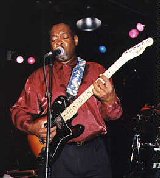 Photo © 1998 by Ray Stiles. All rights reserved |
Before turning to music full-time Carl labored at an Indiana steel mill and worked as a policeman and a prison guard. This gave him some first hand experience into what the blues is all about. This is one powerful blues performer that will leave you amazed and thoroughly entertained.

Table of Contents:
Copyright © 1998 by Ray M. Stiles
[Home Page]
[Message Board]
[Calendar]
[Blues Musicians]
[Blues Clubs]
[Blues Jams]
[New Reviews]
[Live Reviews & Interviews]
[CD Reviews]
[Record Labels]
[Jukebox]
[Photo Gallery]
[Memorial]
[Blues Profiles]
[Blues Links]
[Site Description & Updates]
[Site Awards]
[Spotlight Archives]
[Member Directory]
[Featured Website]
[Website Design & Hosting]
All rights reserved. No part of this publication may be reproduced or transmitted in any form or by any means, electronic or mechanical, including photocopy, or any information storage or retrieval system, without permission in writing from the author.